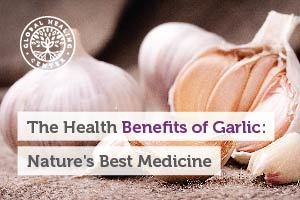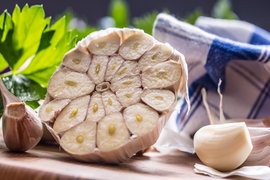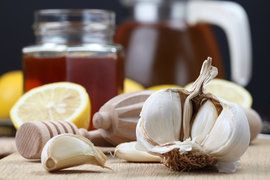
Garlic (Allium sativum) is a plant used in cooking and medicine and best known for its distinctive taste and aroma. Although garlic is often used as a seasoning, it is technically a vegetable. As a member of the Allium family, it is a close relative of onions, shallots, leeks and chives. The benefits of garlic don’t stop at adding flavor to food; it’s a legitimate superfood that has been used for thousands of years for an astonishing variety of medical applications.
History of garlic
People have been consuming garlic as a culinary and medicinal food for more than 7,000 years. The plant is native to Central Asia, but its use and cultivation have spread throughout the world. The ancient Egyptians gave garlic to the workers building the pyramids to increase stamina and prevent disease. In ancient Greece, Olympic athletes chewed garlic before competing in the games. References to garlic can be found in Homer’s Odyssey, 5000 year old Indian medical texts and the Bible. Garlic was used as food and medicine in the cultures of the ancient Romans, Chinese, Vikings, Phoenicians, Israelites and Persians.
Now garlic remains a popular food and flavoring agent. It is a staple of Mediterranean, Indian, Middle Eastern, Chinese and Southeast Asian cuisines. In fact, garlic’s potential medical applications are receiving renewed interest from researchers.
The nutritional profile of garlic
At first glance, garlic’s nutritional values may seem confusing. When you look at the official nutrition facts for garlic, a typical serving of garlic (3-9 grams) does not provide a significant amount of the commonly listed essential nutrients. It does not provide any significant amount of fiber, protein, iron, potassium or vitamins A, D, E or most B vitamins.
It is a good source of selenium and contains small amounts of calcium, magnesium, phosphorus and vitamins C and B6, but there are better sources of these nutrients. You’d have to eat a lot of raw garlic to get a substantial amount of these nutrients, and even though it’s delicious, I think few of us are up to that challenge.
So what exactly is in garlic that makes it such a valued health support tool in so many different cultures? Garlic owes its healing properties to the presence of several sulfur-containing phytochemical compounds. Fresh garlic contains a sulfoxide compound called alliin. When fresh garlic is chopped, crushed, or damaged, alliin is converted into allicin by an enzyme called alliinase. Allicin is responsible for much of garlic’s pungent odor. Its actual purpose is to act as a defense mechanism and protect the plant from pests.

Allicin is unstable and further degrades to other sulfur-containing compounds, including diallyl disulfide, diallyl trisulfide, and diallyl tetrasulfide. In the human body, diallyl disulfide breaks down into allyl methyl sulfide, the main cause of garlic breath. (Side note: For a natural way to reduce garlic breath, you can suck on a lemon slice, or eat spinach or an apple. These foods all contain substances that mask or break down the garlic odor.)
It is these sulfur-containing compounds that give garlic its healing properties. The pest-resistant properties of allicin still work when the compound is present in the human body. This makes garlic a surprisingly good defense against harmful organisms such as bacteria, viruses, protozoa and fungi.
Diallyl disulfide also possesses antimicrobial properties, as well as anti-cancer and heart-healthy properties. The exact mechanisms behind garlic’s health benefits are not yet fully known, but research is ongoing. We know that garlic can be a powerful tool to support a healthy lifestyle. Here are a few ways garlic can help.
Health Benefits of Garlic
1. Garlic supports cardiovascular health
Garlic is one of the best foods for heart health. Research has shown that garlic lowers cholesterol levels and lowers lipid levels in the blood. Experimental and clinical studies on the cardiovascular benefits of garlic have shown that garlic has a positive effect on atherosclerosis, hyperlipidemia, hypertension and thrombosis.[1] Garlic also appears to have the ability to prevent blood clots. Tests are currently being conducted to investigate the mechanism of this effect.
2. Garlic can help with hypertension
Researchers have found that oral administration of garlic can lower blood pressure in both human and animal studies. Amazingly, there was a measurable response after just a single dose. Chronic oral administration of garlic has a positive effect in the long term. Allicin appears to have a relaxing effect on the smooth muscle cells of the pulmonary artery, allowing the artery to open more completely.[1] This doesn’t mean you can switch to an all-bacon diet and expect to “eliminate” the effects, but when combined with a balanced diet, garlic can significantly improve blood pressure.
3. Garlic is nutritional support against cancer
Around the world, studies have found a link between high garlic intake and a reduced risk of cancer. Increased consumption of garlic is associated with a reduction in cancers of the stomach, colon, esophagus, pancreas, prostate and breast.[2] The United States National Cancer Institute has said that garlic may be the most effective food for cancer prevention.[3]
4. Garlic and diabetes
Garlic can also provide significant benefits for people suffering from diabetes. Experimental studies have shown that garlic lowers blood sugar levels and this hypoglycemic effect has been replicated in animal studies. Treatment for humans is less studied, but looks promising. Garlic has been reported to lower blood cholesterol levels and reduce insulin resistance. However, further research is needed to fully understand garlic’s effect on blood sugar levels in humans.[3]
5. Garlic provides liver protection
Garlic is one of the best foods to help cleanse your liver. It can help soothe the effects of fatty liver disease[4] and provides hepatoprotective effects against certain toxic substances. Studies have shown that garlic can protect liver cells against acetaminophen, gentamycin and nitrates.[3]
6. Antimicrobial properties of garlic
For centuries, traditional medicine has used garlic for its antimicrobial properties. Modern studies have shown that garlic’s antibacterial properties are effective against salmonella, staph infections, clostridium (the cause of botulism), proteus, mycobacterium and H. pylori. Garlic has even been proposed as a treatment for drug-resistant tuberculosis.[3]
The effect of garlic against harmful organisms does not stop with bacteria. It is antiprotozoal, antifungal and even antiviral. In vitro studies have shown that garlic is effective against influenza, cytomegalovirus, rhinovirus (the cause of the common cold), viral pneumonia, rotavirus, herpes simplex 1 and 2, and even HIV.[3] Unfortunately, these results are only confirmed in test tube studies. How garlic’s active compounds interact with viruses in the human system remains to be seen.
Research in people with colds found that those who consumed garlic extract experienced milder symptoms and shorter illness duration than placebo groups, but the exact mechanism behind this phenomenon is still unclear.[5] Further research is needed to better understand the healing power of garlic.
7. Garlic is a powerful antioxidant
Free radicals are unstable molecules that damage DNA and lead to poor health. Garlic contains powerful antioxidants that fight these free radicals. When allicin breaks down, it produces an acid that reacts with the free radicals and stops them. Researchers at Queens University in Ontario believe this may be the most powerful dietary antioxidant ever discovered.[6]
Ways to consume garlic
There are hundreds, if not thousands, of recipes that include garlic. The best way to reap the health benefits of garlic is to consume it raw. Raw garlic can be a bit intense for some, but there are several ways to tone down the spiciness while retaining the full health benefits. My favorite is to add raw garlic to a dressing, like the lemon-garlic dressing used in this cabbage wedge recipe or the balsamic vinaigrette of this green bean salad.
Although it may sound a little strange to those who haven’t tried it yet, you can drink garlic. For a quick boost to the immune system, I like to make a garlic tea:
Classic recipe for garlic tea

Ingredients
- 1 clove of organic garlic
- ½ lime or lemon, juiced
- 1 teaspoon raw organic honey
Directions
- Slice 1 clove of organic garlic very thinly.
- Boil a cup of water.
- Place the chopped garlic in a cup.
- Pour the hot water over the garlic and cover the cup with a small plate.
- Let it sit for 10 minutes.
- Add the juice of half a lime.
- Add half a spoonful of raw organic honey.
If tea isn’t your thing, I have another emergency immune booster. In my opinion, this one is less tasty than the tea, but it gets the job done. Crush two cloves of garlic, mix it with the juice of ten limes and drink it. If it is too hard, add a little fresh orange juice to soften the taste.
More research may be needed, but it is already clear that garlic is an incredible superfood with amazing health benefits. Our ancestors knew this and we are now rediscovering the full power of this pungent vegetable. If you’re not feeling well, eat a few cloves of raw garlic. It may alleviate your ailment, although your friends, family, and coworkers may prefer that you not have any conversations afterwards.
†Results may vary. The information and explanations provided are for educational purposes and are not intended to replace the advice of your doctor. If you have a serious medical condition or health problem, consult your doctor.

